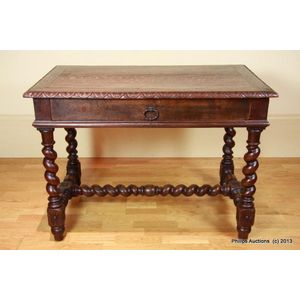Victorian fold-over card table with marquetry decoration
You must be a subscriber, and be logged in to view price and dealer details.
Subscribe Now to view actual auction price for this item
When you subscribe, you have the option of setting the currency in which to display prices to $Au, $US, $NZ or Stg.
- Victorian Period - The Victorian period of furniture and decorative arts design covers the reign of Queen Victoria from 1837 to 1901. There was not one dominant style of furniture in the Victorian period. Designers used and modified many historical styles such as Gothic, Tudor, Elizabethan, English Rococo, Neoclassical and others, although use of some styles, such as English Rococo and Gothic tended to dominate the furniture manufacture of the period.
The Victorian period was preceded by the Regency and William IV periods, and followed by the Edwardian period, named for Edward VII (1841 ? 1910) who was King of the United Kingdom and the British Dominions and Emperor of India for the brief period from 1901 until his death in 1910. - Foldover - A term used when describing card, tea or games tables, where the top folds over onto itself when not in use. The interior surfaces that are exposed when the top is open may be polished (in the case of tea tables) or baized (for card or games tables).
- Figured - A descriptive term to describe the patterns in the grain of timber. An object may be described as "well figured" or "highly figured" if the grain on a section of the object is highly patterned, as with flame mahogany or burr walnut.
- Marquetry - In marquetry inlay, contrasting woods, and other materials such as ivory, shell and metal are inlaid either as panels or in a single continuous sheet over the surface of the piece. The design may be straightforward, such as a shell pattern or a basket of flowers, or it may be infinitely complex, with swirling tendrils of leaves, flowers and foliage, such as one finds, for example, in the "seaweed" patterns on longcase clocks of the William and Mary and Queen Anne periods.
This item has been included into following indexes:
Visually similar items

A fine Victorian burr walnut games table, circa 1860s, having a rectangular outline with lobed ends, with delicate marquetry inlay to the centre and ebony and satinwood banding opening to a green baize interior, supported on four fluted legs with garlic bu

A French oak Louis XIII style desk, circa 1880s, with a mitred top edged in low relief with a continuous foliate band above a single drawer with an iron rope twist ring handle, supported on barley twist legs with turned rosette carved bases and with confor

An early D-end side table, Australian cedar with ring turn legs, circa 1830. 69 cm high, 123 cm wide, 55 cm deep

A French mahogany Louis XVI-style bureau Plat/ centre table, late 19th century, a rectangular top with lobed ends above a skirt with fluting and a frieze drawer with a ribbon and foliate motif centrally and to the reverse, supported on fluted tapering turn
